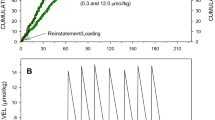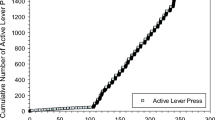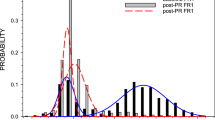Abstract
A BASIC procedure in behavioural pharmacology is the establishment of a dose-effect curve which describes the relation between drug dosage and performance in a certain set of maintaining conditions. Typically, a few animals are trained to work on a particular reinforcement schedule until performance is stable from day to day. Each subject serves as his own control and receives each dose two or three times, one experimental session being devoted to each administration of each dose level. Drug sessions are usually separated by 4–6 days. At least one control session, during which no drug is administered, is run between drug sessions to allow assessment of possible changes in the base-line performance and to provide a further point on the dose-effect curve. A speedier technique is that of cumulative dosing1. Successive presentations of increasingly larger doses are made at fixed intervals throughout a single long session, and performance during this session is compared with performance during a similar session in which the drug is not administered. Inasmuch as these techniques are concerned with a comparison between on drug and drug administration, then the non-pharmacological differences between drug and control procedures are interesting, to our knowledge, control procedures for injection have not been investigated, and a worried novice finds little advice on the matter in standard texts1,2. During the establishment of a dose-effect curve relating chloropromazine dosage and the performance of rats working on a schedule of reinforcement which prescribed food delivery for every fifth lever press (FR5), we employed different control procedures at different stages of the study and found variations in baseline performance which seemed to be related to the differences in control procedure.
This is a preview of subscription content, access via your institution
Access options
Subscribe to this journal
Receive 51 print issues and online access
$199.00 per year
only $3.90 per issue
Buy this article
- Purchase on Springer Link
- Instant access to full article PDF
Prices may be subject to local taxes which are calculated during checkout
Similar content being viewed by others
References
Boren, J. J., in Operant Behavior: Areas of Research and Application (edit. by Honig, W. K.) (Appleton–Century–Crofts, New York, 1966).
Drugs and Behavior (edit. by Uhr, L., and Miller, J. G.) (John Wiley, New York, 1960).
Siegel, S., Nonparametric Statistics (McGraw-Hill, New York, 1956).
Author information
Authors and Affiliations
Rights and permissions
About this article
Cite this article
BEATON, J., GILBERT, R. Injection Controls for Drug Studies. Nature 218, 391–392 (1968). https://doi.org/10.1038/218391a0
Received:
Issue Date:
DOI: https://doi.org/10.1038/218391a0
Comments
By submitting a comment you agree to abide by our Terms and Community Guidelines. If you find something abusive or that does not comply with our terms or guidelines please flag it as inappropriate.



